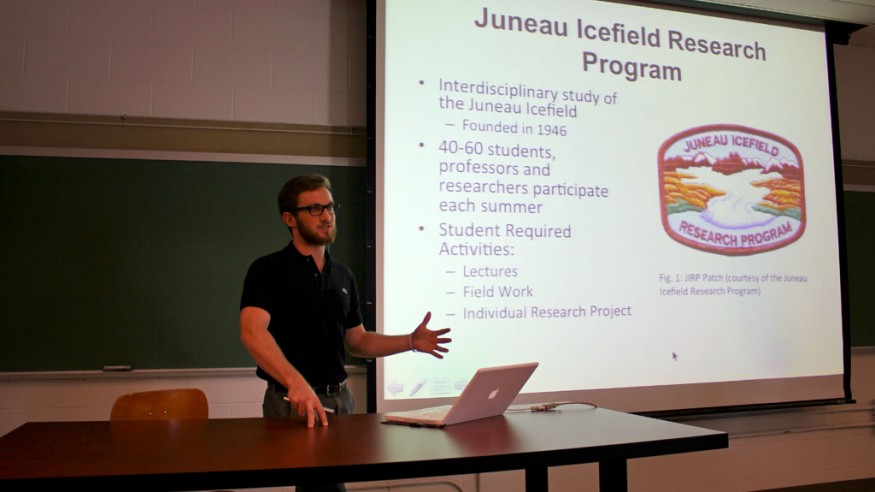
Summer of Science
Zeke Brechtel ’13 is pictured here during a Wednesday noon presentation about his research on katabatic wind flows. (Photo by Andy Wittenberg ’13)
Several researchers, faculty members, and students were engaged and educated as Ohio Wesleyan senior Zeke Brechtel ’13 discussed how he was going to study katabatic wind flows—wind caused by the downward motion of cold air—on the ice fields of Juneau, Alaska.
Bretchtel’s research, as part of OWU’s Summer Science Research Program (SSRP), is being funded by Ohio Wesleyan. Most who watched Brechtel’s presentation—OWU students, faculty, and undergraduates from other universities—are working on scientific projects of their own.
Participating in SSRP are 15 students whose research is being funded by OWU for their 10 weeks of cutting edge scientific research this summer. The researchers are overseen by 11 Ohio Wesleyan faculty advisers.
Research topics include everything from stellar surface imaging via light curve inversion, to the stability of freshwater ponds.
Students Ellen Defenderfer ’13 and Riane Ramsey ’13—overseen by faculty adviser Dr. Lynda Hall—are researching the way cognition changes with age and how this affects reading comprehension. They will administer a naming test, as well as tests for recall and recognition, reading comprehension, and other tests to elderly people and college-aged students. The researchers said they believe age will affect the ratio of the amount of accessible knowledge to the amount of available knowledge one has.
Ramsey discussed the positive implications their research could have.
“This study will prove beneficial to society as it provides insight into how age-related changes in accessibility of knowledge influence performance on complex cognitive tasks. It also has potential to provide new information about how younger and older adults differ in reading comprehension in a second language (Spanish).”
Laura Tuhela-Reuning, event coordinator for the SSRP, said Ohio Wesleyan science programs are about encouraging students to participate in science, “whether that experience is embedded in a class lab, is a freshman honors tutorial, is an independent study project, is part of SSRP, or is a part of a research project at a laboratory at another university.”
She feels that from these types of research, students become scientists—learning how to design and perform experiments, collect and analyze data, and communicate science.
Clare Edwards ’13 and Victoria Sellers ’13 and faculty advisor Dr. Jennifer Yates are testing a lab-only drug, 6-Chloro Tryptophan, and its effects on guinea pig spinal injury. When an injury occurs, an immune response follows, according to Sellers.
“This inflammatory response by the central nervous system … includes the production of a neurotoxin called quinolinic acid, which kills neurons,” she said.
When administering the 6-Chloro Tryptophan, the researchers hope to disrupt the quinolinic acid, preserve neurons, and thus prevent spinal injury after an initial impact.
The researchers use guinea pigs as their test subjects because their spine’s response to injury mirrors that of humans.
Edwards says she appreciates her research opportunity.
“I’ve really enjoyed the entire process we’ve gone through with SSRP. My favorite thing about this research is all of the skills/procedures I am learning.
Yates puts a heavy emphasis on independence in the lab, so that has really pushed us to learn new skills quickly and correctly—as well as to problem solve on our own,” Edwards said.
Yates discusses her research’s significance: “Spinal cord injury can be an extremely debilitating condition, and there are few therapies available for treatment.” She says preventing secondary damage could improve quality of life.
Faculty advisor Dr. Shala Hankison and Mary Ann Lee ’13 are evaluating why females choose one male over another in their research. They are looking at sailfin mollies, fish. In their tests, the male fish will have different amounts of alleles, (an allele is an alternative form of a gene that is located at a specific position on a chromosome) and they will record how that affects mate selection.
Hankison said their research allows people to understand the mating aspect in evolution and diversity.
“Understanding the MHC gene region and preferences for it may give us insight into how organisms may have responded over time to parasites, bacteria, and other immune challenges,” she said.
Students will present their research at noon on September 17, 2012 at the Patricia Belt Conrades Summer Science Research Symposium, which will be held in the Schimmel-Conrades Science Center Atrium.
Additionally, some students will present their findings at meetings for their professional societies.
The public is encouraged to attend the symposium.
